Are the bears retreating into the forest?

We continue with soybeans, where prices have been increasing since June 2023. We are now entering the harvest period. This week's US employment figures could be crucial for the Fed's upcoming September interest rate decision. Looking at the charts from a technical point of view, the bulls will have better days ahead in the short term, while the bears should be slightly worried.
Case of the week: Entering the US harvest season will be a decider
Soybeans are entering the harvest season after a period of uncertainty. Since June 2023, soybeans have been in an uptrend, going from USD 1,200 per bushel to 1,400. However, with sketchy weather in the USA and uncertain demand from China, soybean futures are set to enter into a period of heightened volatility.
The current weather report for the central USA is that the coming months will be a scorcher, with higher temperatures and dryer weather. For harvesting, soybean crops are very vulnerable and need stable temperatures. The expected hot and arid weather pushed down the US 2023 forecast from Pro Farmer, with production estimated at 4,110 billion bushels, or 122.7 million tonnes. This compares to the most recent estimates of the USDA forecast of 4.205 billion bushels. With the weather most prominent in the central states, the uncertainty of the harvest yield is very high.
Soybeans planted acres by county, USDA
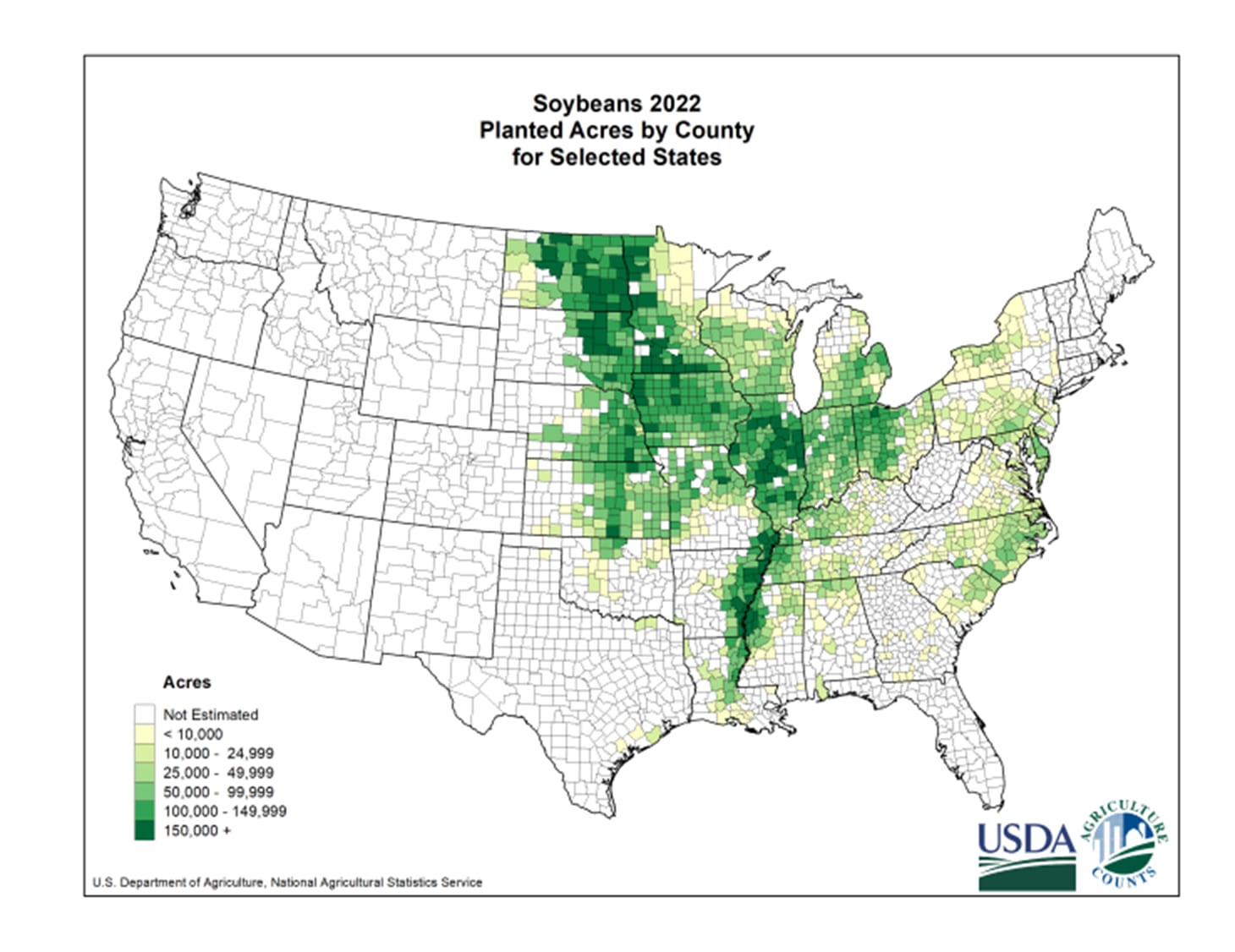
While the USA is looking to come up short, Brazil has been slow to sell the yield from the 2022/2023 harvest. With over 155 million tonnes harvested in Brazil, estimated by USDA, the harvest broke the previous record by 11%. The sharp decline in prices following the start of the harvest means that a lot of supply remains unsold, waiting for better prices and more robust demand.
The final big producer in Argentina has had one of the worst seasons in a long time, with soybean crushing at 15-year lows. This has led the country to increase soybean meal imports for domestic livestock. As for the big importer, China, demand is solid and stable. Since COVID-19 restrictions were lifted, demand has resurged. This was boosted further by the growth in the domestic swine and poultry sectors.
All taken together, demand appears stable and robust, with supply heading into a crucial phase. The USA harvest will be the decider that either pushes the price back up over USD 1,500 per bushel or, if the weather is bad, causes a downward slide below USD 1,300 per bushel.
Soybean Nov ‘23 future price chart (USD/Bu), one-year daily chart

Soybean Nov ‘23 future price chart (USD/Bu), five-year weekly chart

Important US employment figures this week
The stock market continues to be driven by expectations for the big IT companies in the US. Here, Nvidia beat expectations by 29%, according to Zacks Research, on Wednesday 23d, September 2023. Nvidia's guidance was also positive and better than expected.
Last week, the annual central bank conference was arranged in Jackson Hole, Wyoming, USA. Fed Chairman Jerome Powell's speech can be summarised as balanced and lacking any decisive guidance on whether there will be further rate hikes. Weak PMI figures in Europe and the US point to slow economic activity. This has boosted investor confidence that the Fed will soon turn to rate cuts rather than rate hikes. We are probably close to the peak in interest rates, with inflation falling in both the US and Europe. The Fed's next rate meeting is due on 19-20 September.
US 2-year yield (%), one-year daily chart

The US 2-year Treasury yield is still on a modestly rising trend. Factors such as a vital US labour market and inflation expectations have influenced the chart.
US 2-year yield (%), five-year weekly chart

This week's key macro releases will be the US ADP Private Employment report on Wednesday, the 30th of August, followed by the US Unemployment Claims on Thursday, the 31st of August and the US Non-Farm Payrolls on Friday, the 1st of September. The employment figures could be vital for the Fed's decision on its policy rate on the 20th of September. The market expects 195K new jobs from ADP on Wednesday and 170K from Non-Farm Payrolls on Friday.
The market predicts the ECB will not raise its policy rates in September. Inflation is expected to continue to fall to 5.1 per cent from 5.3 per cent in July and 5.5 per cent in June. At the same time, core inflation is expected to remain flat.
Germany 2-year yield (%), one-year daily chart
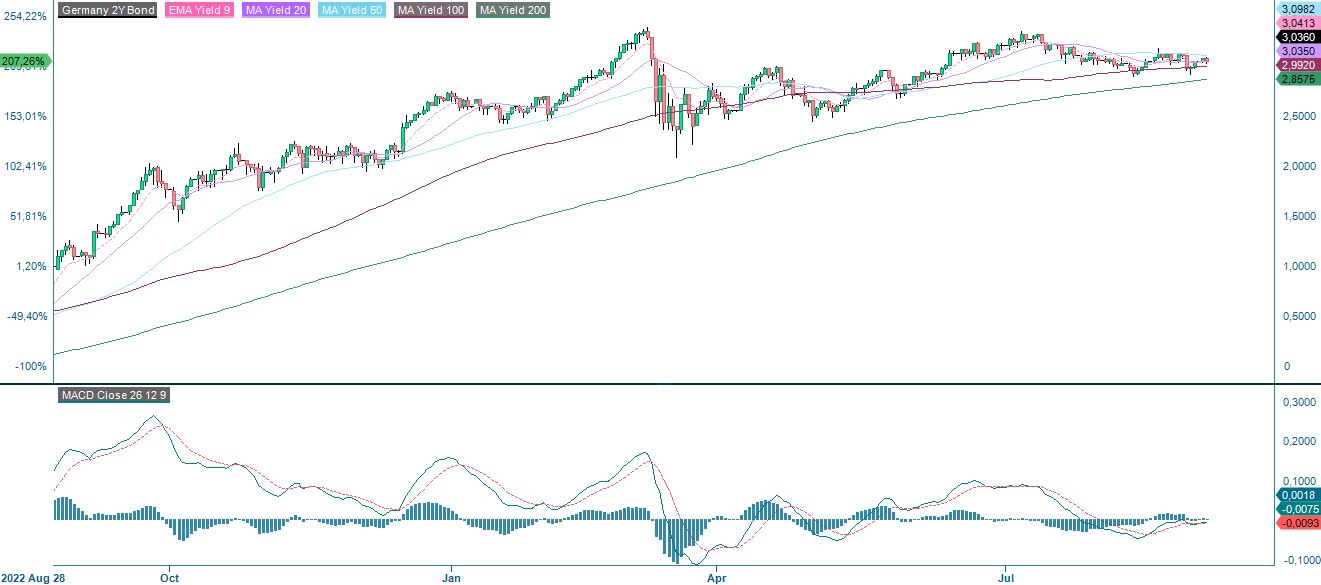
The yield on two-year German government bonds has flattened, with a possible downward tendency. The economy in Europe has not been as strong as in the US, affecting inflation expectations. Since the Euro has been strong, the challenge of imported inflation mainly concerns countries with weaker currencies, such as Sweden.
Germany 2-year yield (%), five-year weekly chart
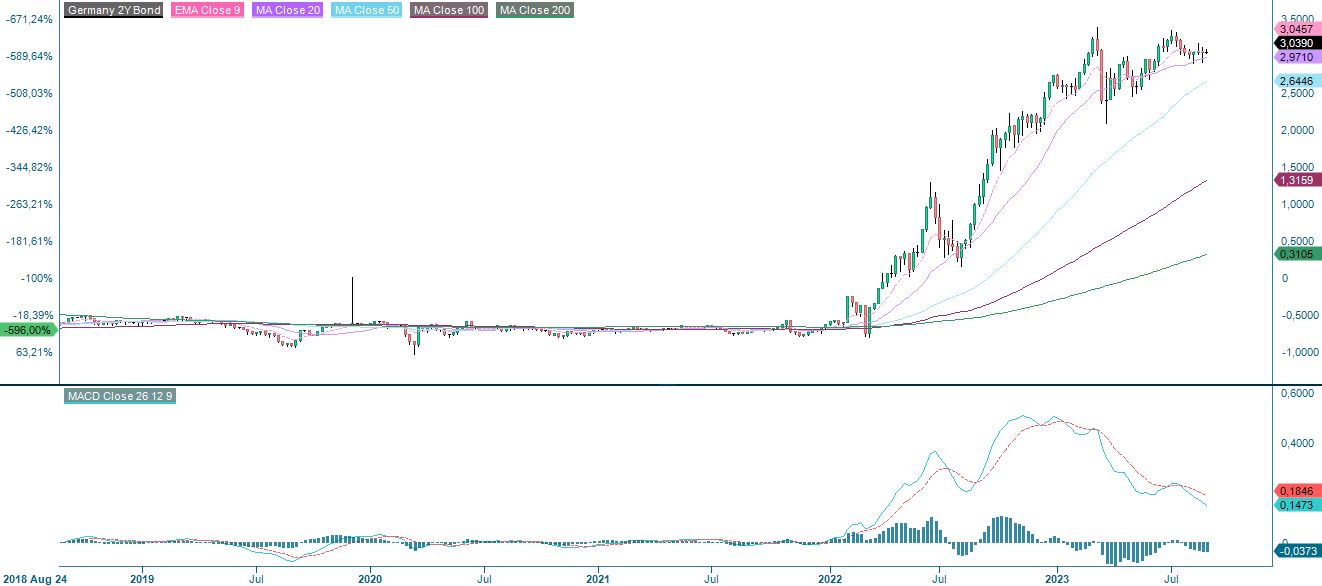
Has the risk flipped to the upside?
As interest rates are coming down, risk may shift to the upside. For the S&P 500, from a technical perspective, MA20 is being tested while MACD is close to generating a soft buy signal. A break above MA20 and the bears should be a little worried. The bulls may be back, and the index approach levels between 4,500-4,600.
S&P 500 (in USD), one-year daily chart
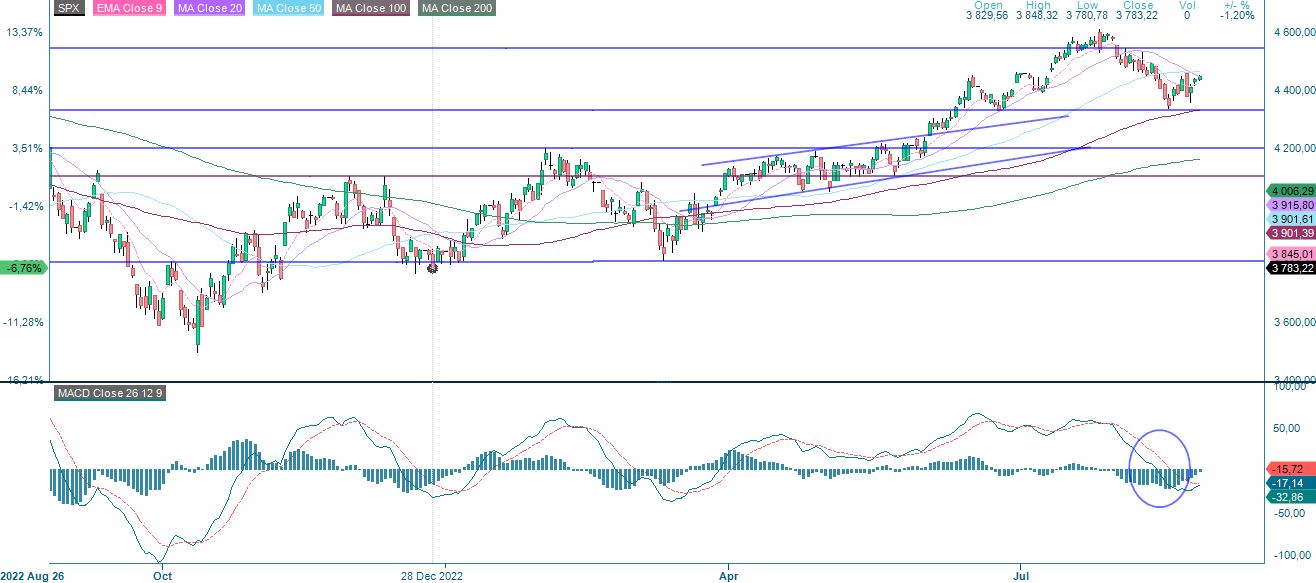
S&P 500 (in USD), weekly five-year chart

The key for the bulls is that the Nasdaq 100 keeps moving upwards and breaks above 15,200-15,220. Note that MACD has already generated a soft buy signal for Nasdaq 100
Nasdaq 100 (in USD), one-year daily chart
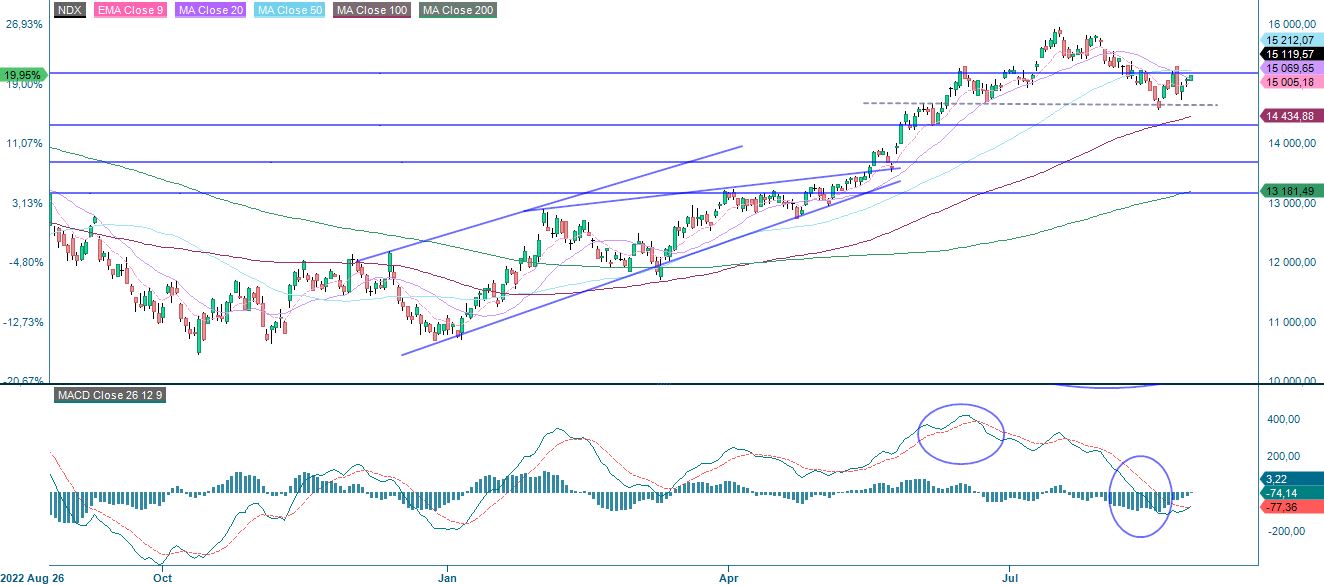
Nasdaq 100 (in USD), weekly five-year chart

OMXS30 needs to retake MA200. Again, MACD has generated a soft buy signal. 2,240 is the next level on the upside.
OMXS30 (in SEK), one-year daily chart
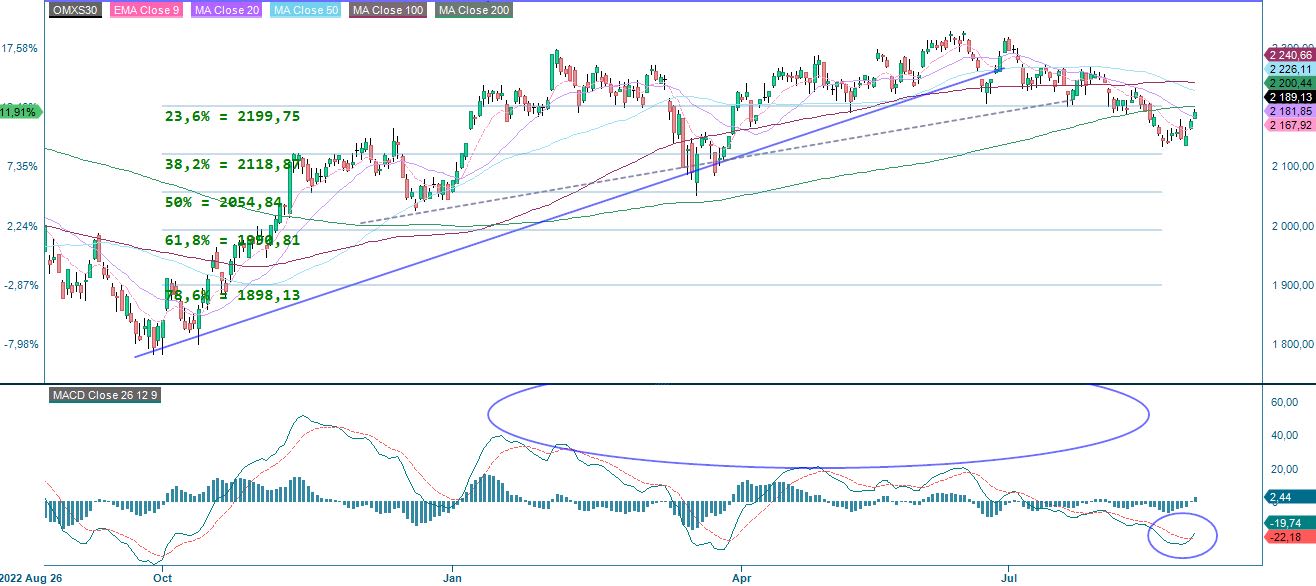
OMXS30 (in SEK), weekly five-year chart

In Germany, 15,800 is an essential level for DAX to retake before the bulls can be considered to have entered the market for real. In case of a break to the upside. The next level can be found around 16,275-16,41.
DAX (in EUR), one-year daily chart
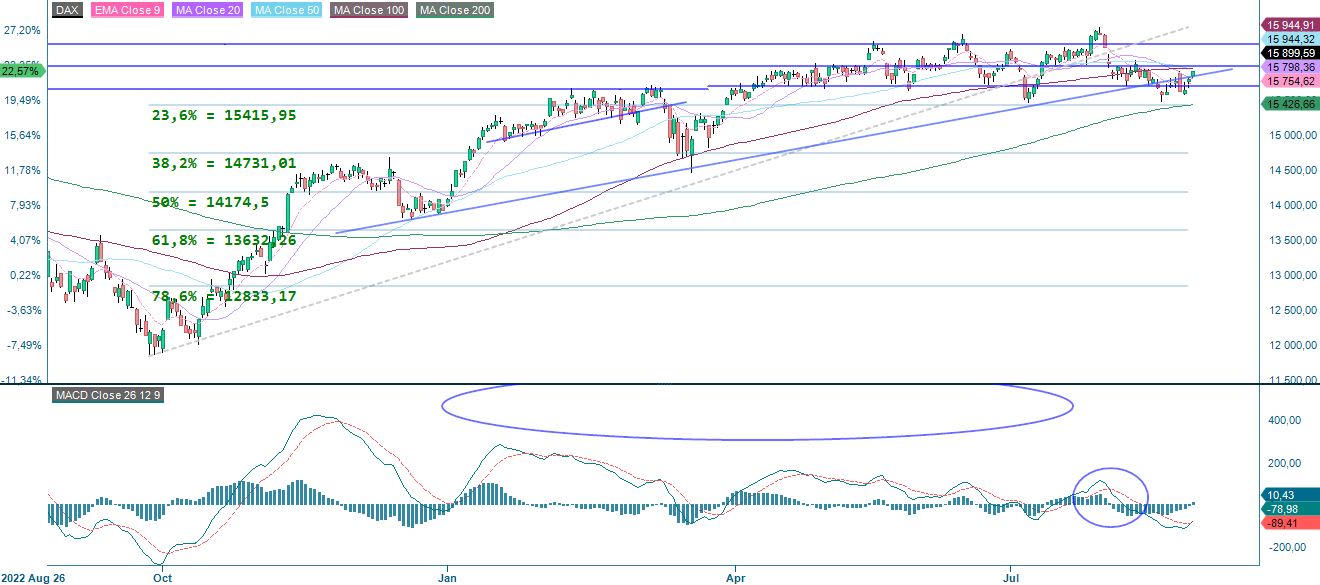
DAX (in EUR), weekly five-year chart

Gold before a potential trend break
Meanwhile, rates in the US are coming down; the USD is losing against the euro around interesting support levels. Is a weaker USD enough to fuel the gold price for a trend break?
Gold (in USD per troy ounce), one-year daily chart

Gold (in USD per troy ounce), weekly five-year chart

The full name for abbreviations used in the previous text:
EMA 9: 9-day exponential moving average
Fibonacci: There are several Fibonacci lines used in technical analysis. Fibonacci numbers are a sequence in which each successive number is the sum of the two previous numbers.
MA20: 20-day moving average
MA50: 50-day moving average
MA100: 100-day moving average
MA200: 200-day moving average
MACD: Moving average convergence divergence
Risici
External author:
This information is in the sole responsibility of the guest author and does not necessarily represent the opinion of Bank Vontobel Europe AG or any other company of the Vontobel Group. The further development of the index or a company as well as its share price depends on a large number of company-, group- and sector-specific as well as economic factors. When forming his investment decision, each investor must take into account the risk of price losses. Please note that investing in these products will not generate ongoing income.
The products are not capital protected, in the worst case a total loss of the invested capital is possible. In the event of insolvency of the issuer and the guarantor, the investor bears the risk of a total loss of his investment. In any case, investors should note that past performance and / or analysts' opinions are no adequate indicator of future performance. The performance of the underlyings depends on a variety of economic, entrepreneurial and political factors that should be taken into account in the formation of a market expectation.
Disclaimer:
This information is neither an investment advice nor an investment or investment strategy recommendation, but advertisement. The complete information on the trading products (securities) mentioned herein, in particular the structure and risks associated with an investment, are described in the base prospectus, together with any supplements, as well as the final terms. The base prospectus and final terms constitute the solely binding sales documents for the securities and are available under the product links. It is recommended that potential investors read these documents before making any investment decision. The documents and the key information document are published on the website of the issuer, Vontobel Financial Products GmbH, Bockenheimer Landstrasse 24, 60323 Frankfurt am Main, Germany, on prospectus.vontobel.com and are available from the issuer free of charge. The approval of the prospectus should not be understood as an endorsement of the securities. The securities are products that are not simple and may be difficult to understand. This information includes or relates to figures of past performance. Past performance is not a reliable indicator of future performance.
© Bank Vontobel Europe AG and/or its affiliates. All rights reserved.
